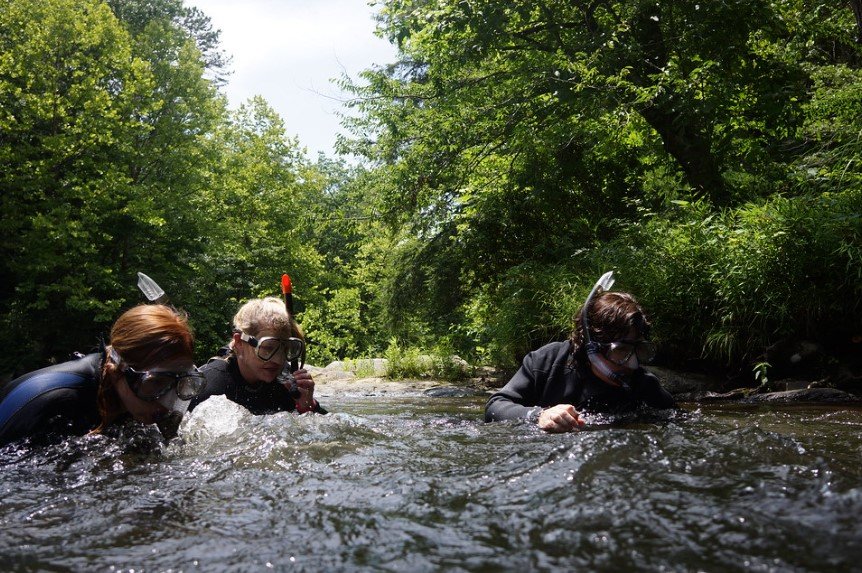In North Georgia’s clear streams, biologists from the state’s Department of Natural Resources have launched a key study to understand how leftover fish hooks affect vulnerable wildlife. Starting in early September 2025, researchers are tracking hook durability in natural settings to protect species like snapping turtles and hellbenders, which face growing risks from abandoned fishing gear.
This effort comes amid rising concerns over fishing waste in waterways. Experts aim to reveal how long hooks last before breaking down, offering insights that could shape better conservation rules and angler habits.
The Study’s Setup and Goals
Thomas Floyd, a wildlife biologist, leads the project in a shaded North Georgia stream. He and his team have placed milk crates filled with hooks in the water to mimic real discarded gear.
Each crate holds around 190 hooks of various types. They measure water flow, temperature, and other factors to see what speeds up or slows rust and decay.
The main focus is on at-risk species. Snapping turtles often swallow hooks while foraging, leading to internal injuries or death. Hellbenders, large salamanders native to these streams, get tangled or hooked, harming their populations.

This research builds on broader environmental worries. Studies show discarded fishing gear kills millions of marine animals yearly, and freshwater impacts are just as serious.
Floyd’s team will check the crates over months. Early data suggests some hooks resist rust longer than expected in cool, flowing water.
Broader Impacts on Wildlife
Discarded hooks pose threats beyond immediate harm. They contribute to ghost fishing, where lost gear keeps trapping animals.
In Georgia, this affects not just turtles and salamanders but also fish and birds. For example, birds can get entangled while hunting near water.
Recent reports highlight similar issues elsewhere. In the Chesapeake Bay, abandoned crab pots trap millions of crabs each year, showing the scale of the problem.
Conservationists warn that without action, at-risk species could decline further. Hellbenders, already rare, face habitat loss from pollution and development too.
- Snapping turtles: Often hook themselves on baited lines left behind.
- Hellbenders: Sensitive to changes in water quality, worsened by metal from rusting hooks.
- Other species: Fish may swallow hooks, leading to starvation or infection.
Experts stress sustainable fishing practices. Using biodegradable gear could cut risks, but tests show mixed results in real conditions.
Science Behind Hook Durability
Hooks are made from materials like carbon steel, which rust over time. But in freshwater, factors like oxygen levels and acidity affect the process.
A 2024 study found some hooks last up to a year without fully dissolving. This prolongs dangers to wildlife.
Georgia’s team is testing different hook types. They record rust rates weekly to build a timeline.
| Hook Material | Average Dissolve Time in Freshwater | Key Factors Influencing Decay |
|---|---|---|
| Carbon Steel | 6-12 months | Water flow, temperature |
| Stainless Steel | Over 2 years | Low oxygen environments |
| Biodegradable | 3-6 months | pH levels, microbial activity |
This table shows why material choice matters. Stainless steel, common in fishing, resists breakdown longest.
Researchers hope findings will push for rules favoring eco-friendly options. Anglers can help by cutting lines if hooks lodge deep in fish, reducing harm.
Links to Climate and Conservation Trends
Climate change adds urgency. Warmer waters speed up some decay but stress species like hellbenders, which need cold streams.
A 2023 review on salmon noted similar climate pressures on fish. Rising temperatures alter habitats, making gear impacts worse.
In Georgia, this ties into bigger efforts. The state has tools for protecting imperiled species, including habitat restoration.
Recent events, like invasive species alerts in 2025, show ongoing threats. For instance, pests harming crops underline the need for vigilant wildlife management.
Biologists connect this to global trends. Ghost fishing costs economies millions in lost marine life, per international studies.
What Anglers and Communities Can Do
People play a big role in solutions. Simple steps can reduce discarded gear.
Education campaigns teach proper disposal. Groups promote catch-and-release with barbless hooks to ease removal.
Communities near streams organize cleanups. In Wyoming, similar efforts have cut wildlife deaths from littered tackle.
Georgia officials urge reporting lost gear. This helps track problem areas.
As this study progresses, it could lead to new guidelines. For now, awareness is key to protecting these streams.
Share your thoughts on fishing impacts or local conservation efforts in the comments below. Spread the word by sharing this article to help safeguard Georgia’s wildlife.
